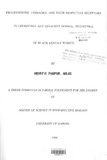| dc.contributor.author | Tabifor, Henry N | |
| dc.date.accessioned | 2013-05-24T08:55:13Z | |
| dc.date.available | 2013-05-24T08:55:13Z | |
| dc.date.issued | 1996 | |
| dc.identifier.citation | Master of Science in Reproductive Biology, University of Nairobi 1996 | en |
| dc.identifier.uri | http://erepository.uonbi.ac.ke:8080/xmlui/handle/11295/25268 | |
| dc.description.abstract | Scientific work has generated a concensus on the involvement
of sex steroid hormones and their respective receptors in the
development of uterine fibroids, but there are$ controversies as r
to the levels of these hormones and receptors in this disease. The
present effort was directed towards resolving this controversy and
to provide information regarding the disease in the black
(negroid) population in Kenya.
Specimens of uterine leiomyomata and the adjacent normal
myometria were collected from twenty patients undergoing
hysterectomy, at the Kenyatta National Hospital Nairobi, for
histological examination and analysis of progesterone (P4)'
estradiol (E2), estrogen receptor (ER) and progesterone receptor
(PR) levels.
The tissues for hormonal and receptor measurements were
homogenized and centrifuged at 27,000 x g for 40 minutes to yield
a supernatant (cytosol). The cytosolic fluids were assayed for
total protein as well as their binding activity to estradiol and
progesterone tracers. Fractions of cytosol were incubated
separately with [(2,4,7-3H)Estradiol] and [17a-Hydroxyl(l,3,6,7-
3H)]Progesterone at 4°c for 48 hours. Using centrifugation bound
and unbound ligand were then separated by charcoal absorption. The
supernatant was counted in a Beta Liquid Scintillation Counter.
The amount of bound hormone per mg protein was calculated.
Estrogen and progesterone receptors (ER & PR) were indirectly
determined by calculating the amount of bound hormone per mg
cytosolic protein while the estradiol and progesterone levels were
determined by radioimmunoassay (RIA). The results showed that the
adjacent normal myometria contained significantly higher levels of
E2 (181.1 % : P<0.001) and P4 (240.6% : P<0.001) compared to the
leiomyomata. The total· P4 in the uterine tissues i.e fibroid and
myometrium was higher (628.4 %) than total E2 in the same tissues.
On the contrary, the uterine leiomyomata contained higher levels
of ER (147.6 % P<0.001) and PR (178.7 % : P<0.001) compared to
the myometria. The total ER was higher (180.5 %) than total PRo
It was therefore concluded that women in the black population
In Kenya have higher levels of E2 and P4 in the adjacent normal
myometrium compared to the leiomyoma. On the other hand, ER and PR
concentrations were higher in the leiomyoma compared to the
adjacent normal myometrium. In the same population total ER
concentration i.e ER in both fibroid and myometrium were higher
than total PR in the same tissues, whereas, total P4 levels were
higher than E2. It is postulated that relative proportions of E2,
P4, ER and PR in individual patients uterine tissue may be
important In the pathogenesis of fibroids in the black population
in Kenya. It is further suggested that treatment and management of
the problem should involve manipulations of the sex steroids and
their receptors.
However, research should continue in order to indentify a
nonsurgical means of treating the disease. This would be an
important public health initiative especially in the black
population where the incidence of fibroids is higher, surgical
complications commoner and childbearing the center of matrimonial
harmony. While hoping for such a breakthrough the importance of
early diagnosis and the detection of high risk groups should be
emphasized in the clinical management of this disease since the
current drug treatment modality only reduces uterine size. | en |
| dc.language.iso | en | en |
| dc.publisher | University of Nairobi, | en |
| dc.title | Progesterone, estradiol and their respective receptors in leiomyoma and adjacent normal myometria of black Kenyan women | en |
| dc.type | Thesis | en |
| dc.description.department | a
Department of Psychiatry, University of Nairobi, ; bDepartment of Mental Health, School of Medicine,
Moi University, Eldoret, Kenya | |
| local.publisher | Department of Veterinary Anatomy and Physiology | en |

